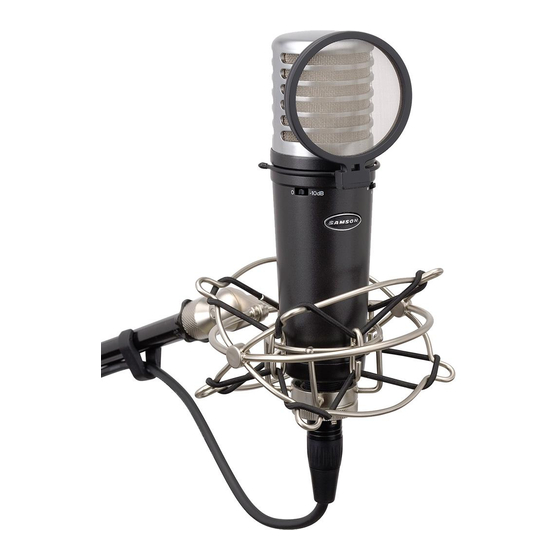
Advertisement
Quick Links
Advertisement

Summary of Contents for Samson MTR231
- Page 2 It is recom- mended keep the microphone in the case when not being used. In these pages, you’ll find a detailed description of the features of the MTR231, as well as instructions for its setup and use, and full specifications. If your microphone was purchased in the United States, you’ll also find a warranty card...
- Page 3 Features • Large diaphragm multi-pattern studio condenser • Dual 1” gold-sputtered capsule • Smooth and transparent sound reproduction • Selectable pick-up pattern: Omnidirectional, Cardioid, Figure-8 • 48 volt phantom power operation • 10dB attenuation pad • Internal capsule shock mounting •...
- Page 4 Setting the Microphone Level When connecting the MTR231 to a mixer, use a balanced cable and be sure that the input is balanced and connected to a channel that is set for microphone level. Also, be sure that the phantom power is engaged. Most mixers and recorders of reasonable quality will offer a microphone input with mic trim (usually called Trim or Gain) control.
-
Page 5: Polar Pattern
Polar Pattern An important characteristic of any microphone is its directionality or polar pattern. The MTR231 features a dual-membrane capsule allowing for a choice of three individual polar patterns: omnidirectional, unidirectional (cardioid), and bidirec- tional (figure-8). The microphone pattern can be selected using the three-position slide switch below the right side of the grill. - Page 6 10dB Attenuation Pad The MTR231 includes a 10dB attenuation pad that can be selected with the slide switch located below the grill, which is used to prevent overloading the onboard preamplifier by lowering the input sensitivity of the microphone preamplifier circuit.
-
Page 7: Microphone Placement
Acoustic Guitar There are a variety of ways that the MTR231 can be used to mike an acoustic guitar. Optimal microphone placement will depend on the type of instrument, and what kind of sound you’re looking to capture. It may be necessary to experiment with various positions to achieve full and balanced tone. - Page 8 If you have a pair of MTR231 microphones, try one positioned at the fingerboard and the second over the bridge of the guitar, or have one micro- phone positioned close to the guitar and the second a few feet away to pick up the sound of the room, blending the two sources together.
- Page 9 Stereo Microphone Techniques The term “stereo” will be used here to describe different microphone techniques using multiple channels of audio to create a reproduction of the sound stage over a pair of loudspeakers. There are many approaches that can be used with two or more microphones, but we will focus on three methods: spaced microphones, X/Y coincident pairs and Mid-Side (MS).
- Page 10 Shockmount To isolate the MTR231 from external vibrations and prevent unwanted noises that are transmitted through the stand, the microphone can be fitted on the custom- designed MSM1 spider shockmount. Follow the steps below to install the micro- phone into the shockmount.
- Page 11 The pop filter also helps to protect the microphone element from moisture. The MTR231 features a unique design that enables the MPF1 pop filter to be mounted directly to the microphone.
- Page 12 Dimensions ..ø54mm x 191.7mm Weight... . . 552g At Samson, we are continually improving our products, therefore specifications and images are subject to change without notice.
-
Page 13: Technical Specifications
Technical Specifications Omnidirectional 1000 2000 5000 10000 20000 Hz Frequency Response Polar Pattern Cardioid 1000 2000 5000 10000 20000 Hz Frequency Response Polar Pattern Figure-8 1000 2000 5000 10000 20000 Hz Frequency Response Polar Pattern...















Need help?
Do you have a question about the MTR231 and is the answer not in the manual?
Questions and answers